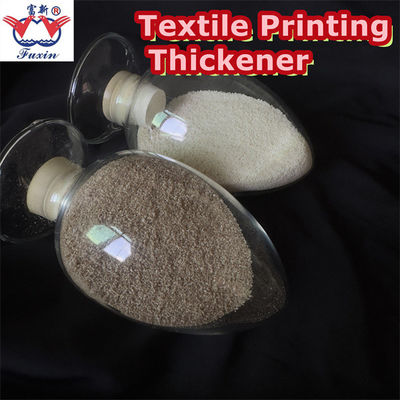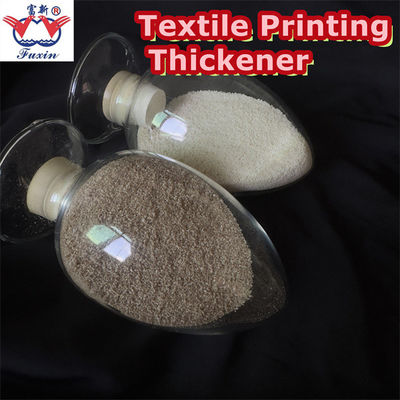Product Description:
Textile Printing Thickener is a specialized product used in the textile industry that can increase the viscosity and thickness of printing pastes and inks. Its primary purpose is to regulate the flow and distribution of the printing medium across the fabric, resulting in a higher quality and more visually appealing print.
Adding Textile Printing Thickener to printing pastes and inks has a number of benefits. It can make the printing process easier and faster, as well as contribute to higher quality prints with improved clarity and color saturation. This type of thickener also helps to ensure that the print is evenly spread and adhered onto the fabric.
By using Textile Printing Thickener, printers can achieve remarkable results that weren't previously possible. Not only can they save time and money, but also they can deliver excellent print quality that exceeds customer expectations.
Features:
High color yield (10%-20% higher than sodium alginate), which can directly reduce dye consumption costs.
Good chemical stability, good compatibility with printing and dyeing auxiliaries and dyes, not easy to spoil during storage, no need to add preservatives.
Chemical stability of color paste is much better than sodium alginate, especially in summer.
Good water retention and high structural viscosity. It has good shear thinning performance under the action of shear stress, excellent screen penetration performance, uniform printing block surface, high outline definition, and smooth lines.
It has good solubility and can be quickly dissolved in cold water under stirring conditions, no gum clump, saving beating time.
Easy to wash off and good hand feeling.
The cost-effectiveness advantage is obvious. Compared with sodium alginate, it can directly reduce the use cost and improve economic benefits.
Technical Parameters:
Performance of Ultra High DS CMC


1st pic:Dyed color granular CMC 2% solution 2nd pic: The left is standard product made in Italy. The middle and right are Fuxin different types of CMC.
Specification
| TYPE |
Degree of Substitution (DS) |
Viscosity
(Brookfield,1%soln.,20℃)
|
pH |
Moisture |
Particle Size |
| 10H |
1 |
2500-3000cps |
6.5-8.5 |
≤15% |
20-70 mesh |
| 13H |
1.3 |
1500-2500cps |
| 15H |
1.5 |
1000-2000cps |
| 18H |
1.8 |
800-1600cps |
| Y002 |
2 |
800-1500cps |
| Y230 |
2.3 |
600-1000cps |
*Kindly contact us for specification and information about any specific grade of CMC other than mentioned in the above table.
Powder or granular available, we recomed customer to purchase the brown granle type CMC to sell as sodium alginate for higher profit.
Technique Process
▲Dissolve the dyes and add into the paste, make the color paste with thickener→▲Printing→▲Drying (100 ℃)→▲Baking or steaming→▲Washing→▲Soaping→▲Rinsing→▲Post treatment procedure.
Dissolution Methods and Proportion:
How to make the paste?
1. The ratio depends on DS level, low DS product should mix with pure sodium alginate to reach a better performance, while ultra high DS product can 100% replace SA.
2. Proportion: same as sodium alginate original paste preparing. Firstly add 65% water, stir the water while adding the product evenly and slowly, then speed up the stirrer for 20-25 minutes. And then add the remaining 35% water, stir for another 20-30 minutes. Leave for 15 minutes.
How to make sure the paste dissove completely?
1. Powder and water completely fuse, not exist solid-liquid separation phenomenon.
2. Paste is dissolved evenly, the surface is smooth, no granular objects.
Applications:
Pigment Printing: Textile Printing Thickener is utilized to thicken pigment pastes, which are then applied onto the fabric surface. This helps in preventing bleeding or spreading of the pigment, resulting in sharp and well-defined prints.
Reactive Printing: Reactive dyes are commonly used for printing intricate designs on textiles. The Textile Printing Thickener is employed to thicken the dye solution, allowing for better control over the dye penetration and fixation onto the fabric. This ensures clear and vibrant prints with excellent color fastness.
Discharge Printing: Discharge printing involves the removal of color from pre-dyed fabrics to create intricate designs. The Textile Printing Thickener is used to thicken the discharge paste, which helps in controlling the removal process and achieving precise patterns or motifs.
Resist Printing: In resist printing, a resist agent is applied to specific areas of the fabric to prevent dye penetration. The Textile Printing Thickener is used to thicken the resist paste, enabling precise application and ensuring that the resist agent does not spread beyond the desired boundaries.
Flock Printing: Flock printing involves the application of fine fibers onto the fabric surface to create a textured or raised effect. The Textile Printing Thickener is employed to thicken the adhesive paste used to hold the flock fibers in place, ensuring proper adhesion and durability of the printed design.
Support and Services:
We provide technical support and service for Textile Printing Thickener. Our service includes:
- Application and technical support
- Product selection advice
- Efficiency optimization
- Technical training
- Product customization
- After-sale maintenance
Packing and Shipping:
Textile Printing Thickener is packaged in 25-kg bags and shipped in cardboard boxes.

 Your message must be between 20-3,000 characters!
Your message must be between 20-3,000 characters! Please check your E-mail!
Please check your E-mail!  Your message must be between 20-3,000 characters!
Your message must be between 20-3,000 characters! Please check your E-mail!
Please check your E-mail! 



